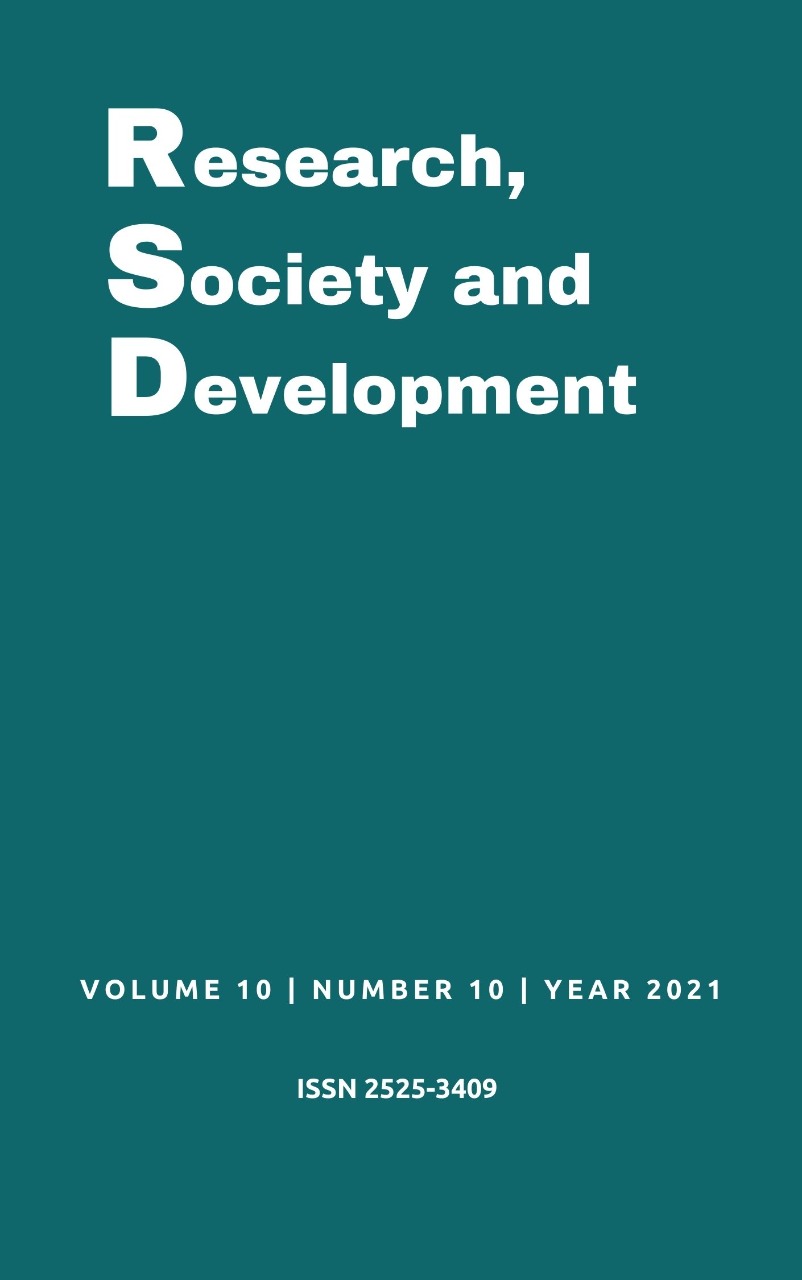Influência dos parâmetros no desenvolvimento de deslizamentos em encostas da Estrada de Ferro Vitória-Minas
DOI:
https://doi.org/10.33448/rsd-v10i10.19300Palavras-chave:
Deslizamentos de encostas, Parâmetros influenciadores de deslizamentos, Estrada de Ferro Vitória-Minas, Estatística multivariada, Análise de componente principal.Resumo
Deslizamentos têm sido objeto de grandes estudos no mundo, não apenas por sua importância como agentes modificadores do relevo, mas também por causarem danos e prejuízos a pessoas e estruturas expostas, afetando vários tipos de empreendimentos. O objetivo deste estudo foi a determinação de parâmetros influenciadores no desenvolvimento de deslizamentos nas encostas da Estrada de Ferro Vitória-Minas (EFVM). A EFVM está localizada na região sudeste do Brasil, é uma ferrovia importante para o transporte de minério de ferro para as siderúrgicas e para exportação, bem como para o transporte de passageiros. O banco de dados aqui utilizado foi coletado a partir de trabalhos de campo na EFVM, juntamente com o processamento de imagens e dados de testes laboratoriais. Os parâmetros selecionados para serem avaliados foram limites de Atterberg, coesão, ângulo de atrito, permeabilidade e classificação do solo nas encostas. Foram feitas estimativas dos volumes e áreas de deslizamentos de terra que já ocorreram nas encostas. Dentre os parâmetros estudados, os resultados obtidos para os limites de Atteberg e a coesão do solo foram os mais correlacionados com os resultados de campo, o que está de acordo com outros estudos da literatura. Conclui-se que os limites de Atterberg estão diretamente relacionados às rupturas do solo, e a coesão do solo contribui para a estabilização do solo nas encostas.
Referências
Ahmed, B. & Dewan, A. (2017) Application of bivariate and mul-tivariate statistical techniques in landslide susceptibilitymodeling in Chittagong City corporation, Bangladesh. Remote Sensing, 304:1–32
Cattell, R. B. (1966). The screen test for the number of factors. Multivariate Behavioral Research, 1, 140–161.
Gomes, R. C. (2014). Setorização Geológico-Geotécnica da Via e Avaliação e Controle de Riscos Geotécnicos dos Taludes da EFVM. Relatório Técnico Final. Ouro Preto: Universidade Federal de Ouro Preto.
Guidicini, G. & Nieble, C. M. (1984). Estabilidade de taludes naturais e de escavação. São Paulo: Edgard Blücher - Ed. da Universidade de São Paulo. 194p.
Guo, D., Hamanda, M., He, C., Wang, Y., Zou, Y. (2014). An empirical model for landslide travel distance prediction in Wenchuan earthquake area. Landslides, 11(2): 281-291.
Guzzetti, F., Ardizzone, F., Cardinali, M., Rossi, M., & Valigi, D. (2009). Landslide volumes and landslide mobilization rates in Umbria, central Italy. Earth and Planetary Science Letters, 279, 222-229.
IAEG. (1990). Commission on Landslides. Suggested nomenclature for landslide the International Association of Engineering Geology, 41, 13–16 pp.
Kaiser, H. F. (1958). The varimax criterion for analytic rotation in factor analysis, Psychometrika, 23, 187-200.
Júnior, H. C. & Cabral, S. C. (2019). Tecnologias no mapeamento de áreas de risco de deslizamento em Teófilo Otoni. Research, Society and Development, 8 (12): e018121353.
Kulatilake, P. H. S. W., Hudaverdi, T., & Wu, Q. (2012) New predictionmodels for mean particle size in rock blast fragmentation. Geotechnical and Geological Engineering, 30:665–684
Lee, Y. F. & Chi, Y. Y. (2011). Rainfall-induced landslide risk at Lushan, Taiwan. Engineering Geology 123, 113–121.
Massumi, A. & Gholami, F. (2016) The influence of seismic inten-sity parameters on structural damage of RC buildings using principal component analysis. Applied Mathematical Modelling, 40:2161–2176
Pedrosa, A. De A., Almeida, S. M. De, & Lafayette, K. P. V. (2020). Análise de encosta em situação de risco no município de Olinda-PE. Research, Society and Development, 9 (11): e3499119817.
Santos, A. E. M., Lana, M. S., Cabral, I. E., Pereira, T. M., Naghadehi, M. Z., da Silva, D. F. S., & dos Santos, T. B. (2018). Evaluation of rock slope stability conditions through discriminant analysis. Geotechnical and Geological Engineering, 37, 775–802.
Santos, A. E. M. & Silva, D. F. S. (2021). Stability conditions evaluation of slope by multivariate analysis. Holos. 37 (3), 1-13.
Santos, A. E. M., Silva, D. De F. S. Da, Mendonça, G. A., Santos, T. V., Amaral, R. R., & Silva, L. A. M. (2020). Índice de queda de blocos e caracterização geológica-geotécnica em taludes rodoviários: um estudo de caso na BR-262. Research, Society and Development, 9 (12): e12891210968.
Silva, D. F. S., Corteletti, R. C., Filgueiras, R. A. C. Santos, A. E. M. (2021). Correlations between landslide scars parameters using remote sensing methods in the Estrada De Ferro Vitória-Minas, southeastern Brazil. Revista Brasileira de Geomorfologia, 22 (2): 297-314.
Silva, D. De F. S. Da & Santos, A. E. M. (2020). Rockfall hazard assessment and geological-geotechnical characterization of a rock slope in BR-356. Holos. 36(8), 1-13.
Silva, D. F. S., Santos, A. E. M., Ferreira, B. T., Pereira, T. M., & Corteletti, R. C. (2018). Cluster analysis for slope geotechnical prioritization of intervention for the Estrada de Ferro Vitória-Minas. REM - International Engineering Journal, 71 (2):167-173.
Terzaghi, K. (1950). Mechanisms of Landslides, Geotechnical Society of America, Berkeley, 83-125.
Vale. (2018). Sobre a Vale. Notícias. <http://www.vale.com/brasil/PT/aboutvale/news/Paginas/ferrovia-vitoria-minas-transportou-119-milhoes-toneladas-cerca-1-milhao-pessoas-2014.aspx>.
Varnes, D. J. (1978). Slope movement types and processes. In: Landslides and Engineering Practice.
Downloads
Publicado
Edição
Seção
Licença
Copyright (c) 2021 Denise de Fátima Santos da Silva; Rosyelle Cristina Corteletti; Allan Erlikhman Medeiros Santos; Elaine Aparecida Santos da Silva

Este trabalho está licenciado sob uma licença Creative Commons Attribution 4.0 International License.
Autores que publicam nesta revista concordam com os seguintes termos:
1) Autores mantém os direitos autorais e concedem à revista o direito de primeira publicação, com o trabalho simultaneamente licenciado sob a Licença Creative Commons Attribution que permite o compartilhamento do trabalho com reconhecimento da autoria e publicação inicial nesta revista.
2) Autores têm autorização para assumir contratos adicionais separadamente, para distribuição não-exclusiva da versão do trabalho publicada nesta revista (ex.: publicar em repositório institucional ou como capítulo de livro), com reconhecimento de autoria e publicação inicial nesta revista.
3) Autores têm permissão e são estimulados a publicar e distribuir seu trabalho online (ex.: em repositórios institucionais ou na sua página pessoal) a qualquer ponto antes ou durante o processo editorial, já que isso pode gerar alterações produtivas, bem como aumentar o impacto e a citação do trabalho publicado.


